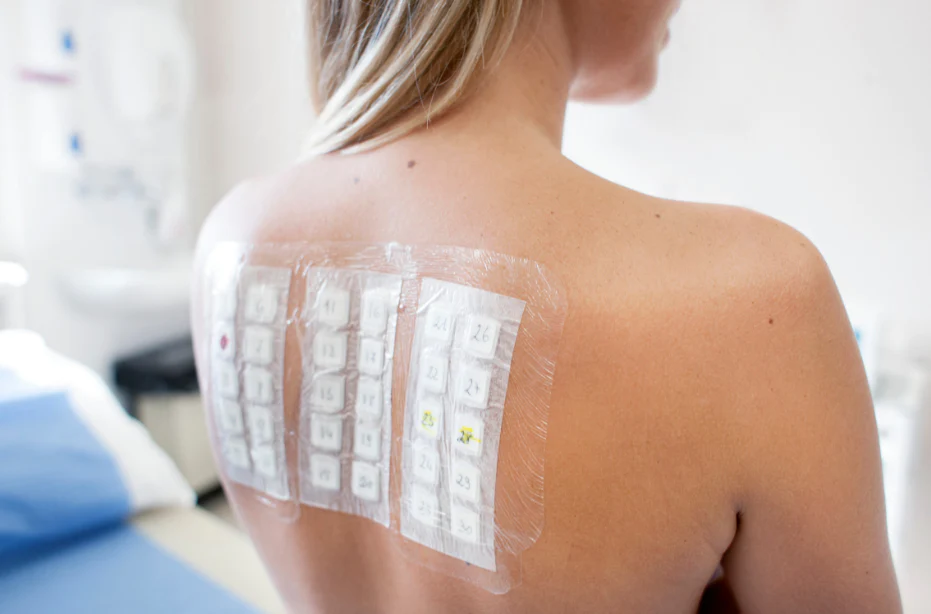What Is Patch Testing?
Patch testing is an allergy test used to identify specific substances that may be causing an allergic reaction on the skin. It is commonly performed to determine the cause of allergic contact dermatitis, which is a type of delayed hypersensitivity reaction.
During patch testing, a series of small patches or panels containing different substances or allergens are applied to the patient’s back. These substances can include chemicals, fragrances, metals, preservatives, and other common allergens. The patches are usually held in place with hypoallergenic tape and left on the skin for a specific period, typically 48 to 72 hours.
Advantages of Patch Testing
Patch testing offers many advantages over other allergy testing methods. Firstly, it provides an accurate assessment of your skin allergies. It is considered the most accurate testing method when dealing with contact dermatitis. This allows allergists to prescribe the correct treatment so you get relief from your allergies. An allergist is able to craft a personalized treatment plan on the same day of your appointment.
Another advantage of patch testing is that it can help improve occupational safety. Patch testing is particularly valuable in occupational settings where exposure to specific allergens is common. By identifying workplace-related allergens, employers can implement preventive measures, such as providing protective equipment or substituting hazardous substances, to ensure the safety and well-being of employees.
Disadvantages of Patch Testing
While patch testing is used widely and considered accurate for contact allergens, there are some disadvantages to using it. First, patch testing can be a time-consuming process. Patch testing requires multiple visits to a healthcare professional over a span of several days. Each visit involves the application and removal of patches containing potential allergens. This can be inconvenient and time-consuming for patients, especially those with busy schedules.
This test also produces delayed results. Patch testing typically involves leaving the patches on the skin for a specific period, often 48 to 72 hours, before the results are assessed. This waiting period can cause discomfort or itching for some individuals, and it may lead to delays in receiving a definitive diagnosis.
Since patch testing focuses on identifying allergens that cause allergic contact dermatitis on the skin, it may not be useful in diagnosing other types of allergies, such as respiratory allergies (e.g., pollen, dust mites) or food allergies. Different diagnostic methods, such as skin prick testing or blood tests, are more appropriate for these types of allergies.
How to Prepare For Patch Testing
To prepare for patch testing, inform your allergist about all medications you are currently taking, including prescription drugs, over-the-counter medications, herbal supplements, and vitamins. Some medications can interfere with patch testing and may need to be temporarily avoided or adjusted prior to the test.
You should also avoid sun exposure during the week leading up to the patch testing. Sunburn or tanned skin can affect the test results and make it difficult to interpret the reactions. Plus, remember to wear loose-fitting clothing that won’t rub against the test area and potentially dislodge the patches.
When Is Patch Testing Necessary?
If you experience unexplained skin reactions, you should visit an allergy specialist and undergo patch testing. If you suspect that a specific substance or product is causing an allergic reaction on your skin, patch testing can help confirm or rule out that allergen. It can provide valuable information about substances to avoid in the future and guide you in selecting suitable products.
At NY Allergy & Sinus Centers, we can perform patch testing and provide a personalized treatment plan upon receiving your results. Contact one of our allergy specialists to get started today.
Patch Testing Frequently Asked Questions
How Long Does Patch Testing Take?
The patches are usually left on the skin for 48 to 72 hours. However, the exact duration may vary depending on the specific substances being tested and your allergist’s preference.
Can Patch Testing Be Performed On Infants and Young Children?
Patch testing can be challenging to perform on infants and young children. So, allergists usually advise against it unless medically necessary.
Does Patch Testing Always Produce Accurate Results?
Patch testing is considered a valuable and accurate tool for identifying specific substances that can trigger allergic contact dermatitis in individuals. However, like any medical test, patch testing may not always produce definitive or completely accurate results.
Will Taking Medications Affect Patch Testing?
Yes, taking certain medications can affect the results of patch testing. Medications that can interfere with skin prick testing include antihistamines and oral or topical corticosteroids.
Can Patch Testing Diagnose Food Allergies?
No, patch testing is primarily used for diagnosing allergic contact dermatitis caused by substances that come into contact with the skin. It is not designed to diagnose food allergies or immediate allergic reactions. Other tests, such as skin prick tests or blood tests, are typically used for diagnosing food allergies.
Can Patch Testing Be Done If I Have Eczema or Active Skin Rashes?
In general, patch testing should not be performed on active skin rashes or areas of significant eczema because it can lead to inaccurate results.

